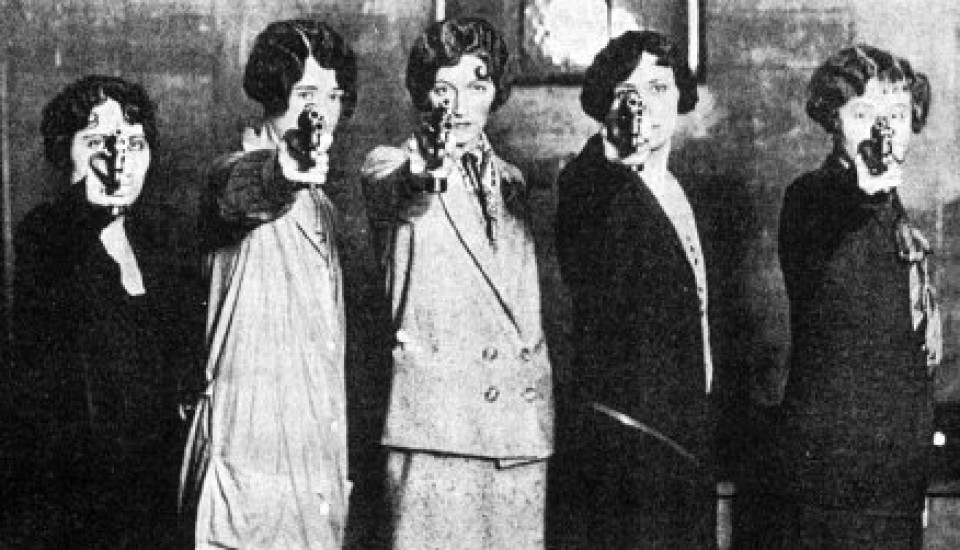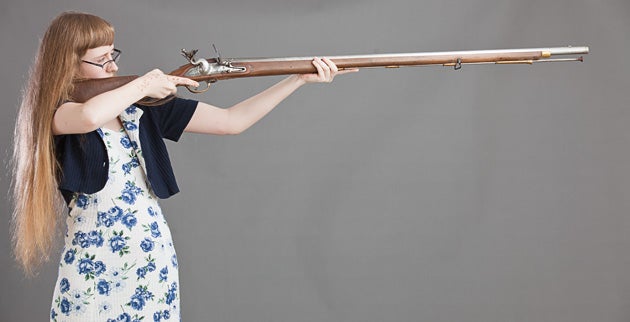This is a great article, please read on. Thanks to “Alloutdoor”!
Selecting the right gun for teaching a new shooter
fit and comfort matter
Posted July 8, 2013 in Shooting by Oleg Volk
200 1 192

Hefting the Brown Bess musket shows excessive length of pull, too much weight. The same shooter runs an M4 carbine comfortably.
Learning to shoot can be stressful even for adults. Guns can be heavy, ranges are usually noisy, and managing recoil and muzzle blast requires concentration. The learning challenge is that much greater for kids who are often much smaller than adult shooters, may lack the strength to hold up a firearm or to operate some of its controls. Add to this shorter attention span and the impressionable nature of children and the first range trip becomes a high-stakes proposition for the coach. Start out wrong and the interest can quickly change to aversion. Here are the things to consider when picking out a firearm for your child’s first range trip:
This kid has been shooting since age 3, so the controls of vz58 are not a mystery to him. The light weight, short stock and thin grip of the carbine fit his small stature well.
Length of pull, the distance from the buttplate to the trigger. If the shooter cannot reach the trigger comfortably, the contortions required to fire the gun would make it harder to manage recoil. This is where adjustable length stocks really shine! They even allow changing the length depending on the shooting position. With a fixed stock, child-length rifles like Crickett and Henry Mini Bolt are excellent. The length can be extended for older children using slip-on recoil pads. For more experienced kids, certain adult guns like M1 carbine and vz58 provide the necessary short length of pull coupled with moderate recoil. With pistols, the distance from the grip backstrap to the trigger also has to be short enough for small hands. Here, single-action revolvers and smaller handguns like the Walther P22 and Ruger SR22 win over double-action designs with longer, heavier trigger pulls. For pump-action shotguns and rifles, including the rimfire carbines, verify that the shooter can reach the forend comfortably.
Simplicity of operation. For an experienced shooter, the controls of a rifle like an AR-15 become fairly intuitive. But for an absolute novice, the simplest actions are often best. The Thompson Center break-open Hot Shot is an excellent example: the breechface is easily visible for checking the gun status, and the gun has only three controls (the trigger, the loading lever and the hammer). Short and weighing in at only 3 pounds, the Hot Shot is an excellent trainer for kids as young as 5. By contrast, various repeater .22 rifles are better suited for slightly older and more experienced learners.
Reasonable levels of noise and recoil. 22LR is popular for a reason. It produces very little kick and a moderate report. 22Short is entirely acceptable for those guns that accept it, as the difference in accuracy and bullet drop won’t be an issue at the very short distances recommended for the first try. We have all seen videos of new shooters falling victim to practical jokes involving a shotgun and a magnum cartridge. The idiots who set up new shooters to fail and to have a negative first experience are as much an enemy of gun culture as the outright prohibitionists! Don’t underestimate the psychological component to recoil — 22WMR out of a revolver might not have much kick, but the noise can startle the unprepared. Err on the side of less power and lower noise — if you can, use sound-suppressed guns for teaching.
Reasonable weight and balance. The most accurate bull barrel target rifle will be a waste if the shooter cannot heft it. Adults usually underestimate the great difference between their own strength and that of small children. So forget anything over about five pounds for pre-teens, unless the gun is always used from a bipod or sandbags. Bullpups are often easier to hold up, but the length of pull is excessive with most.
Trigger weight. Light triggers may sound like a safety hazard, but they are not nearly as dangerous as the heavy triggers in the hands of low-strength shooters. In order to pull a 10lb trigger on a double-action revolver, a child would likely have to push harder against the grip, leading the muzzle off target. If muzzle control becomes an issue, switch to long guns — it’s easier for the coach to arrest the untoward movement of a rifle barrel than to check a handgun pointed to the sidelines by accident.
Left-hand variant of .223Rem Ruger 77 is just right for this 12 year old marksman. The tapered barrel is light enough to balance, and a moderate load combined with correct stock length means the recoil is not a problem.
Correct controls for the child’s preferred hand. Some rifles are equally convenient for left and right handed shooters. Falling and rolling blocks, break actions are among those, as are certain forward-ejecting bullpups. Most pump actions have ambidextrous controls and loading but eject on the right. The same is true of many lever actions. Bolt action and semi-auto guns present the greatest challenge, the first because of the awkward loading process for the opposite-handed shooters, the second due to energetic ejection right past the shooter’s face. Fortunately, left-hand firearms exist and should be used for teaching. The Army makes everyone learn right-hand M16s, but we have the luxury of customizing the firearms to the shooters. A recruit in basic training has to suck it up and shoot despite the poor fit, but a child does not and may elect to leave the range if the experience becomes too uncomfortable.
Sights should be fitted to the kid’s preference. I’ve seen kids who could not understand the concept of peep sight alignment do fine with notch and post sights. I’ve also seen kids who could shoot great with red dots or low power scopes but got frustrated with iron sights. My recommendation is to figure out which sights the kids like best before coming to the range, then get them zeroed ahead of time. It matters less what type of sighting they prefer at first, so long as they are comfortable with it. The purpose of the first range trip is not to only to teach the basics but to provide the most positive experience possible, ensuring enthusiasm for more range trips in the future. For the same reason, a preference should be given to shooting at short ranges, with either large, easy paper targets or reactive targets such as clays or tins. 25 and even 15 yards is a very long distance for a first-time young shooter, while starting at 3-5 yards gets them bragging rights in the form of photogenic bullsyes.
Since predicting likes and dislikes is difficult, I would suggest letting your child handle a variety of guns, either at home or at a gun store. They are likely to have much stronger preferences between different types than adults would. It’s also worth testing for eye dominance. Cross-eye dominant shooters especially would have problems with iron sights and would be better served with red dots that allow shooting with both eyes open and the non-domiant eye behind the gun.
- See more at: http://www.alloutdoor.com/2013/07/08/fit-comfort-matter/#sthash.sfC3VWY2.dpuf



